Lady Justice (Justitia): Legal And Philosophical Concept Produced In Remote Antiquity
A. Sutherland - AncientPages.com - We call her today - Lady Justice. Her modern statues frequently decorate courthouses and courtrooms in many countries worldwide.
Additionally, images of Justice can be found virtually anywhere. They appear on sculptures, bas-reliefs, statues, paintings, porcelain, stained glass, seals, coins, sometimes on medals, logos of certain websites, and even on clothes.
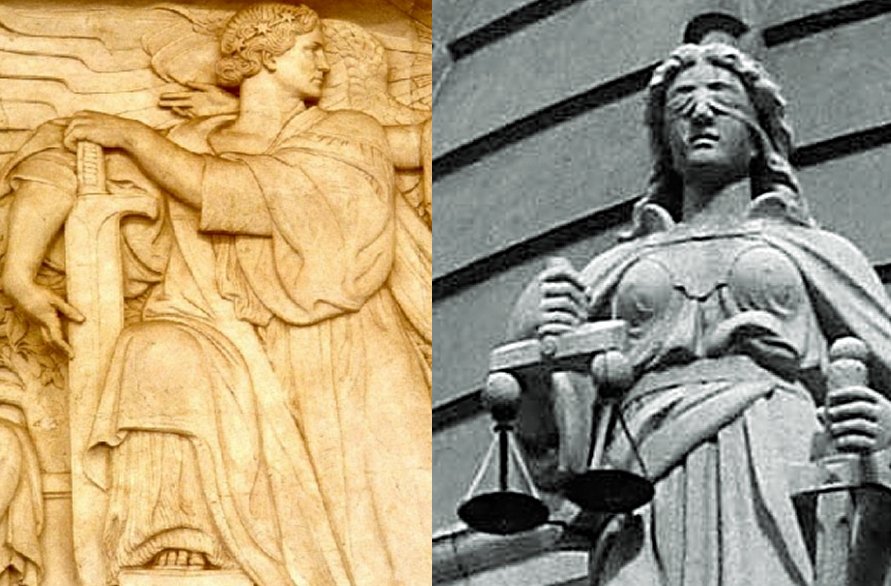 Left: A robed Justice (without blindfold) is the focus of the allegorical story of the battle of Good Versus Evil. Her unencumbered gaze is set determinedly in the direction of the forces of Evil, to the viewer’s right.(One of the Courtroom friezes sculpted by Adolph Weinman). Source; Right: Justitia blindfolded and holding balance scales and a sword. Court of Final Appeal, Hong Kong. Source
Left: A robed Justice (without blindfold) is the focus of the allegorical story of the battle of Good Versus Evil. Her unencumbered gaze is set determinedly in the direction of the forces of Evil, to the viewer’s right.(One of the Courtroom friezes sculpted by Adolph Weinman). Source; Right: Justitia blindfolded and holding balance scales and a sword. Court of Final Appeal, Hong Kong. Source
In the past, creating an image of Justice was not easy. Many artists seemingly asked themselves simple questions: How to paint Justice? What does she look like?
After all, Justice is an idea, a specific legal and philosophical concept, which means that artists could not use the model of Justice; they could only create their impression of her.
In ancient Rome, she was called Iustitia (Justitia). In Greece, she was equal to the goddesses: Themis ("the Lady of good counsel") and the personification of law, divine order, divine Justice, natural law, right, fairness, and custom), and Dike (the goddess of human Justice and the spirit of moral order and fair judgment).
It was long believed that in the Golden Age, she lived on earth, and then, with the rise of human wickedness, she left the planet and went to the sky to dwell in the constellation of Virgo.
Long Tradition Of Lady Justice
Her prototype was the Egyptian goddess Maat Ma'at (Mayet), symbolizing and personifying the ancient Egyptian concepts of order, Justice, harmony, law, truth, balance, and morality.
In Egypt, the idea of law, divine order, and truth were personified by the goddess Ma'at, presented as a young woman holding a set of scales in one hand and a symbol of eternal life - the sign of Ankh.
Appearance, Attributes And Their Meaning
As depicted on the statues, Lady Justice has a long robe/dress, a sword, and the scales of Justice and is usually (but not always) wearing a blindfold.
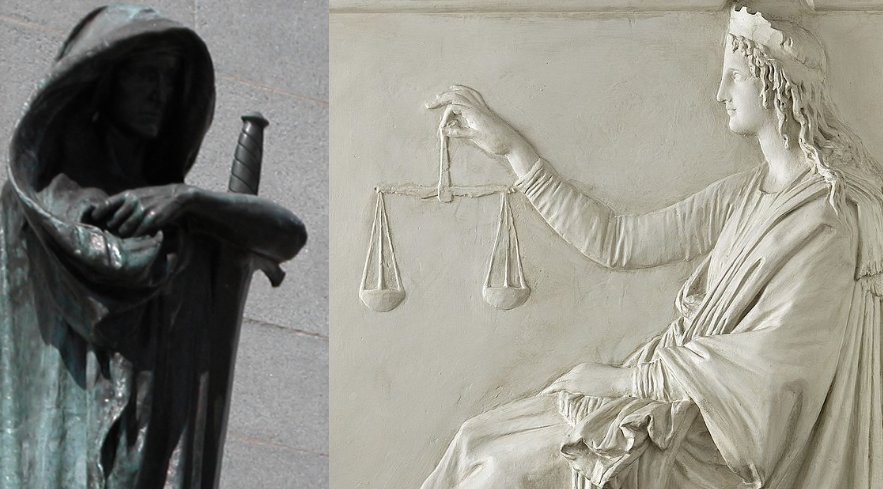 Left: Statue of Justice outside the Supreme Court of Canada in the capital city, Ottawa in the province, Ontario; source; Right: The bas-relief of the Goddess of Justice. source
Left: Statue of Justice outside the Supreme Court of Canada in the capital city, Ottawa in the province, Ontario; source; Right: The bas-relief of the Goddess of Justice. source
These attributes are of great importance due to their symbolism. Carrying a double-edged sword in her right hand, Lady Justice wants to emphasize the power of reason and Justice, which can be used for or against an individual.
The sword in the hand of the Lady of Justice means even more. It symbolizes authority exercised by emperors, kings, and other influential individuals. It can also be used against a king or ruler's power and cease it in the blink of an eye.
Blindfold Justice - Obliged To Be Objective
The blindfold represents objectivity with no place for prejudice or passion.
Therefore, also, the Lady of Justice must act objectively and without favor or fear. Her decisions must be weighed on the scales and done without regard for a person's identity, power or weakness, money, or rank.
However, the earliest Roman coins depicted Justitia with her eyes uncovered.
One argument for Justitia's naked eyes was to urge judges to consider cases with their open eyes.
One example is the statue of the Lady of Justice - without a blindfold - atop the Old Bailey courthouse in London. Later, since the end of the fifteenth century, she was commonly represented as "blind."
The Scales Will Decide About A Verdict
A set of scales has a long history. It was placed before the temple to weigh the deeds of the deceased. Nemesis, a winged goddess of Justice and revenge, is portrayed with a set of scales and a sword. Also, Atropos, one of the Moirai, was occasionally depicted with a pair of scales. In the Book of the Dead, Anubis, the "Guardian of the Scales," participates in the Weighing of the Heart ceremony.
He performs a measurement that determines whether the person is worthy of entering Duat (the realm of the dead).
Lady of Justice holds a set of scales in her left hand because she is responsible for measuring the strength of a case's support and opposition.
The scales in her hand will decide a verdict.
Lady Justice Represents One Of Four Virtues
Christianity's four classic cardinal virtues symbolize temperance, courage, prudence, and Justice.
In ancient Roma, Justice (Iustitia) was celebrated by Augustus, a Roman statesman and military leader who became the first emperor of the Roman Empire, reigning from 27 BC until he died in AD 14. A few years later, emperor Tiberius ordered to build of a temple of Iustitia in Rome on 8 January 13 BC.
From now on, Justice (Iustitia) became a symbol of Justice with which every Roman emperor associated his rule.
Written by – A. Sutherland - AncientPages.com Senior Staff Writer
Updated on January 30, 2023
Copyright © AncientPages.com All rights reserved. This material may not be published, broadcast, rewritten or redistributed in whole or part without the express written permission of AncientPages.com
Expand for referencesReferences:
Berger A. Encyclopedic Dictionary of Roman Law
Tremblay Luc B. The Rule of Law, Justice, and Interpretation
More From Ancient Pages
-
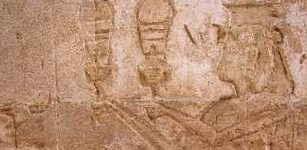 Female Pharaoh Twosret Was Exploited, Used And Almost Erased From History
Featured Stories | Apr 11, 2019
Female Pharaoh Twosret Was Exploited, Used And Almost Erased From History
Featured Stories | Apr 11, 2019 -
 Seven New Ancient Buddhist Caves – One With ‘A Harmika’ – Discovered In Mumbai
News | Jan 19, 2016
Seven New Ancient Buddhist Caves – One With ‘A Harmika’ – Discovered In Mumbai
News | Jan 19, 2016 -
 Anne Neville – The Dramatical Story Of The White Queen
Featured Stories | May 22, 2020
Anne Neville – The Dramatical Story Of The White Queen
Featured Stories | May 22, 2020 -
 Knowledge Of Ancient Medicine Hidden In Undeciphered Egyptian Manuscripts
Archaeology | Aug 16, 2018
Knowledge Of Ancient Medicine Hidden In Undeciphered Egyptian Manuscripts
Archaeology | Aug 16, 2018 -
 Tombs Rich In Artifacts Discovered By Swedish Expedition In Cyprus
Archaeology | Jul 6, 2023
Tombs Rich In Artifacts Discovered By Swedish Expedition In Cyprus
Archaeology | Jul 6, 2023 -
 Could Neanderthals Meditate? Scientists Investigate
Archaeology | Jun 30, 2022
Could Neanderthals Meditate? Scientists Investigate
Archaeology | Jun 30, 2022 -
 Surprising Discoveries In Mysterious Giant Viking-Era Cave In Iceland Can Confirm Norse Sagas
Archaeology | May 31, 2022
Surprising Discoveries In Mysterious Giant Viking-Era Cave In Iceland Can Confirm Norse Sagas
Archaeology | May 31, 2022 -
 Victory Tower – An Imposing Victory Monument In Chittorgarh, Rajasthan, India
Civilizations | Jul 28, 2015
Victory Tower – An Imposing Victory Monument In Chittorgarh, Rajasthan, India
Civilizations | Jul 28, 2015 -
 Svarog: God Of Cosmic Fire And Ruler Of The Sky In Pre-Christian Slavic Pantheon
Featured Stories | Aug 15, 2017
Svarog: God Of Cosmic Fire And Ruler Of The Sky In Pre-Christian Slavic Pantheon
Featured Stories | Aug 15, 2017 -
 Meenakshi Temple Of Madurai Is Among Most Powerful Sacred Sites For Hindu People
Featured Stories | Apr 29, 2021
Meenakshi Temple Of Madurai Is Among Most Powerful Sacred Sites For Hindu People
Featured Stories | Apr 29, 2021 -
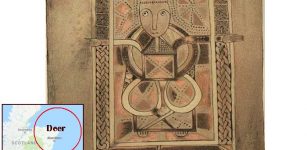 Book Of Deer And The Lost Scottish Monastery – Archaeologists Report New Finds
Archaeology | Jan 10, 2018
Book Of Deer And The Lost Scottish Monastery – Archaeologists Report New Finds
Archaeology | Jan 10, 2018 -
 Map May Confirm The Legend Of The Mysterious Lost Sunken Welsh Kingdom Of Cantre’r Gwaelod In The Black Book Of Carmarthen
Archaeology | Aug 21, 2022
Map May Confirm The Legend Of The Mysterious Lost Sunken Welsh Kingdom Of Cantre’r Gwaelod In The Black Book Of Carmarthen
Archaeology | Aug 21, 2022 -
 1,700-Year-Old Vase For Olive Oil And Wine Unearthed At Historic Site Of Diyarbakir Fortress, Turkey
Archaeology | Aug 5, 2022
1,700-Year-Old Vase For Olive Oil And Wine Unearthed At Historic Site Of Diyarbakir Fortress, Turkey
Archaeology | Aug 5, 2022 -
 Mysterious Advanced Underground Civilization And A Secret Society – Astonishing Discovery And Connection – Part 1
Civilizations | Apr 21, 2018
Mysterious Advanced Underground Civilization And A Secret Society – Astonishing Discovery And Connection – Part 1
Civilizations | Apr 21, 2018 -
 Our Early Ancestors Probably Created Intricate Artwork By Firelight
Archaeology | Apr 21, 2022
Our Early Ancestors Probably Created Intricate Artwork By Firelight
Archaeology | Apr 21, 2022 -
 Ancient Underwater City Of Heracleion Reveals More Archaeological Treasures
Archaeology | Jul 21, 2021
Ancient Underwater City Of Heracleion Reveals More Archaeological Treasures
Archaeology | Jul 21, 2021 -
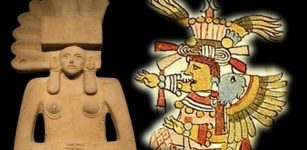 What Was An Aztec Confession?
Ancient History Facts | Jul 25, 2017
What Was An Aztec Confession?
Ancient History Facts | Jul 25, 2017 -
 Legend Of The Sun And Moon In Cherokee Beliefs
Featured Stories | Jul 9, 2019
Legend Of The Sun And Moon In Cherokee Beliefs
Featured Stories | Jul 9, 2019 -
 Unexplained Accounts Of Mysterious Fires – ‘Burning’ Questions Remain Unanswered – Part 1
Featured Stories | Aug 2, 2019
Unexplained Accounts Of Mysterious Fires – ‘Burning’ Questions Remain Unanswered – Part 1
Featured Stories | Aug 2, 2019 -
 Surprising DNA Study Links Present-Day Native American Tribe To Ancestors In San Francisco Bay Area
Archaeology | Mar 22, 2022
Surprising DNA Study Links Present-Day Native American Tribe To Ancestors In San Francisco Bay Area
Archaeology | Mar 22, 2022
